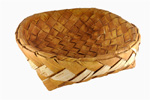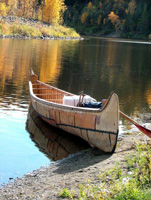
Birch Bark and Its many Uses
It is important to keep in mind that removing the inner layer of bark from any live tree can do irreversible harm to that tree. Removing the inner layer prevents the flow of sap, which will eventually kill the tree if enough bark is removed. You should always look for downed birch trees from which to harvest the bark before cutting into a live tree. The bark from white birch is what is typically used because the bark has a cardboard like consistency. The bark can be used for many things and is ideal material that can be used in a survival situation.
 When some people think of birch bark, they think of canoes made from the bark. Indigenous people around the world used and still do use the bark to cover wooden frames to make canoes or small boats and to make shelters. In a survival situation, a canoe would be ideal in some cases but the effort and time required would make it impractical. The bark can be dried and cut into thin slates to weave baskets and can be made into body armor to protect legs, chest and arms.
When some people think of birch bark, they think of canoes made from the bark. Indigenous people around the world used and still do use the bark to cover wooden frames to make canoes or small boats and to make shelters. In a survival situation, a canoe would be ideal in some cases but the effort and time required would make it impractical. The bark can be dried and cut into thin slates to weave baskets and can be made into body armor to protect legs, chest and arms.
Uses that are more practical include coverings for shelter, tinder and storage containers. It is quite easy to form a bowl out of the bark that can then be used to store water and food or can be used as serving containers.
Harvest the bark in early spring or summer off downed logs by making a shallow slit that only cuts through the outer layer. When cut the bark almost peels itself. Once removed it can be rolled inside out to carry and if using for roofing/shelter or boats lay flat and place weights at the corners so it dries flat. The inner bark can also be used to make cordage by cutting long strips and then separating the fibers into cordage that can be braided or twisted into rope.
 Heating the bark makes it more pliable and Native Americans would heat large sheets by placing on a rack over a fire but not so close the bark was blackened or burned. Then they would remove the sheets and mold the now very pliable bark around the wooden frames of the canoe. Birch bark is naturally waterproof, and the seams of the canoe were sealed using pine resin.
Heating the bark makes it more pliable and Native Americans would heat large sheets by placing on a rack over a fire but not so close the bark was blackened or burned. Then they would remove the sheets and mold the now very pliable bark around the wooden frames of the canoe. Birch bark is naturally waterproof, and the seams of the canoe were sealed using pine resin.
The inner bark of white birch is also edible and many consider it to have medicinal properties. The inner bark can be cooked and eaten or dried and ground into a powder to make breads or to use as a thickening agent in other foods. The oil from the inner bark is an astringent and can be used to treat wounds.
Native Americans considered the inner bark famine food. However, the bark is high in starch and is typically used to make hard breads that could be chewed on along the trail. The sap is said to have a wintergreen flavor and is used to make tea. Harvest as much sap as you can and add water to it and bring to a boil. While the water/sap is boiling, peel some inner bark into small strips and place in a cup and then pour the boiling water and sap over the bark and let steep. The bark is high in vitamin C.
The outer bark is considered to have antibacterial properties, which make it ideal for water and food storage because the bark inhibits bacteria growth. To make a simple eating bowl or vessel to carry water in you will need a section of bark and a fire along with a rock that can be used to mold the bark around. Heat the bark until it is pliable and then mold around the rock and let dry. Once the bark is dry pull the rock away and the bark will maintain the bowl shape. Trim the top so you can drink from it more easily. Make four holes evenly spaced around the rim to add cordage to carry the vessel. If storing water make a lid for the water vessel to prevent contamination.